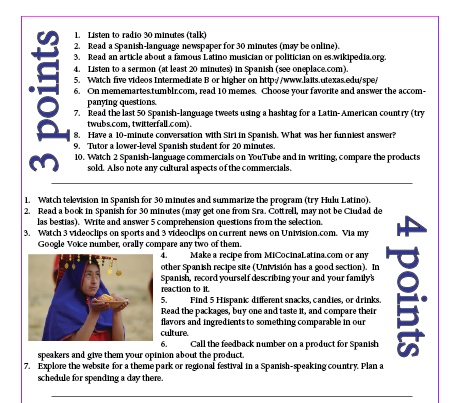Again, I skipped #6 and we’ll get to it later, and you’ve already seen #4 because it was part one of the post also including #8. So here we have the third most-popular post of 2014, the one offering up a more user-friendly version of my choice-in-homework project, along with several adaptations from amazing colleagues. It was published in August, and had it been published earlier in the year, it would have been the top post of the year. It also was the material for a very popular session at ACTFL, which I did with Bethanie Carlson-Drew and Laura Sexton. Teachers far and wide are hungry for ways to access student motivation, and the autonomy that comes when you turn homework on its head in this way is simply and incredibly motivating.
Putting homework in their hands: Sample systems
 When I posted last year about my latest update on the Elige tu propia aventura homework choice activity, the post quickly became one of the top 10 of the year. Accordingly, I frequently receive requests for my list of options and how I divided them into a point system. The problem is that I was experimenting with InDesign to develop my ebook resources and chose it to make my AP syllabus and the Aventura document – and your average teacher isn’t going around with InDesign on her computer. So the best I could offer was a PDF. Plus, I’ve only done this activity with intermediate and pre-advanced students and many teachers wonder what the options would look like for lower levels.
When I posted last year about my latest update on the Elige tu propia aventura homework choice activity, the post quickly became one of the top 10 of the year. Accordingly, I frequently receive requests for my list of options and how I divided them into a point system. The problem is that I was experimenting with InDesign to develop my ebook resources and chose it to make my AP syllabus and the Aventura document – and your average teacher isn’t going around with InDesign on her computer. So the best I could offer was a PDF. Plus, I’ve only done this activity with intermediate and pre-advanced students and many teachers wonder what the options would look like for lower levels.
Wait, what?
Screeching halt.
If you haven’t been with me for the journey through giving up the pretense that trying to excessively manipulate my students’ out-of-class time is going to predict to me what they learn, you could always browse through my choice tag. If you don’t have that kind of time, here’s a run-down:
- Autonomy and intrinsic motivation are high predictors of success in learning.
- Language for communicative purposes cannot be learned in isolation.
- Frustration is common in traditional homework because there’s no one around to help.
- Frustration blocks language acquisition.
- I give two and only two homework assignments per week.
- These assignments are always the same: do an aventura activity and post a free-topic blog
- Student autonomy in these assignments is very important to me.
- These two graded assignments free me from grading or entering grades for most other formative activities.
- As time passed I realized that not all assignments are worth the same either in time commitment or in usefulness for language acquisition.
- Assigning choices a point value allowed me to require students to challenge themselves and to adapt the same list for various learning levels.
- This idea is one of my most widely-used and several other teachers have developed their own lists and systems.
I’m so excited and impressed with how other teachers have adopted and adapted this idea and thought it would be helpful to link all the documents for you here. Plus, I took all the content from my InDesign file and put it in a Google Doc for you to copy/paste and adapt for your situation.
Choice activity documents
My options and point system
Kara Jacobs‘ system
Noah Geisel‘s system
– some Pinterest ideas Noah found useful
Laura Sexton’s options
Tana Krohn‘s list
Bethanie Carlson Drew’s updated list (and I stole the name from her!)
Katherine Matheson’s version
And how could I leave out-
The Creative Language Class’s Real World Homework
(developed completely on their own creative genius!)
1 Comments
Comments are closed.




[…] In the past I have attempted some different things, namely the oh-so-famous (and rightly so) student-selected homework a la Sara-Elizabeth Cottrell of Musicuentos.com. […]